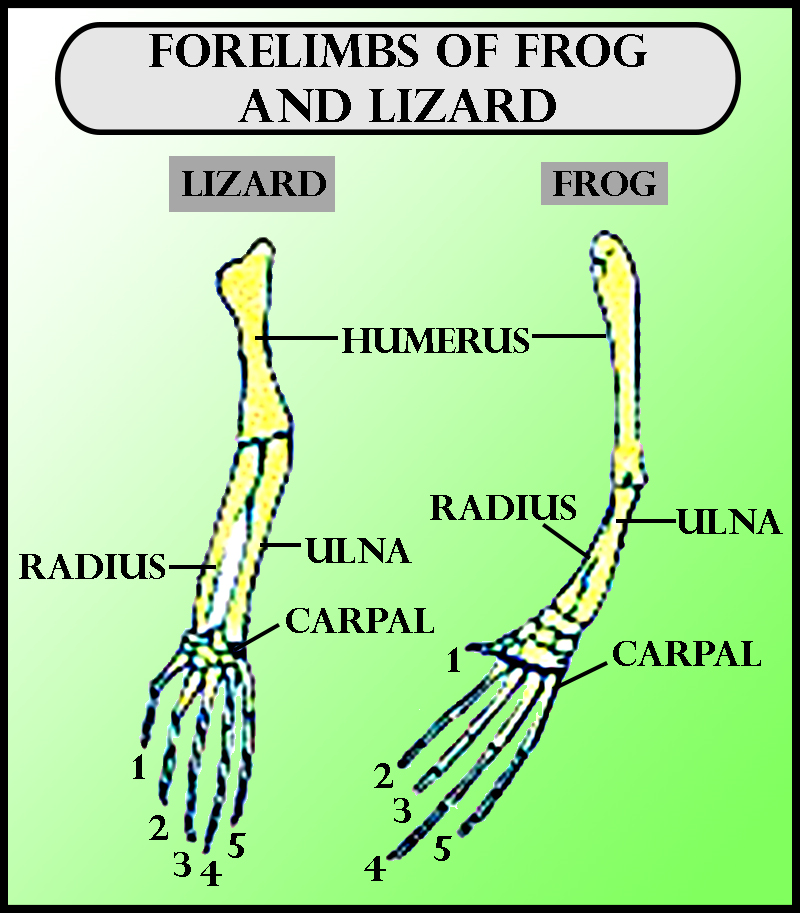
Forelimbs of frogs and lizards are the example of ________ organs.
(a)Homologous
(b)Analogous
(c)Both A and B
(d)None of these
Answer
451.5k+ views
Hint: The forelimbs of lizard and frog share the same anatomical structure but different functions. This similarity arises because they all share a common ancestor but differ in function due to evolution and to survive in their habitat. This is commonly known as divergent evolution.
Complete answer:
Forelimbs of frogs and lizards are the example of homologous organs.
Homologous structures are the anatomically similar structures that have a common ancestor. Even if they are superficially different, they are developmentally related. Homologous structures do not share the same function. The hoping legs of the frog contain the same bones as a lizard’s forelimb, the humerus, the radius, and the ulna but the frog’s legs are highly modified to perform a different function (hoping) and lizard’s leg for locomotion. For example, Limbs of Human, Bat, and Mouse are strikingly similar but, humans write from hand-limbs, mice run, and bat flies.
Additional Information: Analogous organs are those organs that perform the same functions but have different ancestors and structures. For example, the wings of bats and birds have a different structure but perform the same function of flying. It is convergent evolution as despite having different ancestors they are performing the same functions.
There is wide evidence that supports evolution. Two of them are homologous and analogous structures. The difference between them is as follows:
So, the correct answer is ‘Homologous’.
Note: The observations of structural homology support the causal hypothesis of evolutionary homology: that the common structural organization results from common ancestry. The evidence of analogous structures further supports the evolutionary homology concept.

Complete answer:
Forelimbs of frogs and lizards are the example of homologous organs.
Homologous structures are the anatomically similar structures that have a common ancestor. Even if they are superficially different, they are developmentally related. Homologous structures do not share the same function. The hoping legs of the frog contain the same bones as a lizard’s forelimb, the humerus, the radius, and the ulna but the frog’s legs are highly modified to perform a different function (hoping) and lizard’s leg for locomotion. For example, Limbs of Human, Bat, and Mouse are strikingly similar but, humans write from hand-limbs, mice run, and bat flies.
Additional Information: Analogous organs are those organs that perform the same functions but have different ancestors and structures. For example, the wings of bats and birds have a different structure but perform the same function of flying. It is convergent evolution as despite having different ancestors they are performing the same functions.
There is wide evidence that supports evolution. Two of them are homologous and analogous structures. The difference between them is as follows:
| Homologous Structure | Analogous Structure |
| Similar anatomy | Dissimilar anatomy |
| Dissimilar functions | Similar Functions |
| Inherited from a common ancestor | Not inherited from ancestors |
| Develops in related species | Develops in unrelated species |
| A result of divergent evolution | A result of convergent evolution |
| These developed as a result of the adaptation to a different environment | These developed as a result of the adaptation to a similar environment |
So, the correct answer is ‘Homologous’.
Note: The observations of structural homology support the causal hypothesis of evolutionary homology: that the common structural organization results from common ancestry. The evidence of analogous structures further supports the evolutionary homology concept.

Recently Updated Pages
What percentage of the area in India is covered by class 10 social science CBSE

The area of a 6m wide road outside a garden in all class 10 maths CBSE

What is the electric flux through a cube of side 1 class 10 physics CBSE

If one root of x2 x k 0 maybe the square of the other class 10 maths CBSE

The radius and height of a cylinder are in the ratio class 10 maths CBSE

An almirah is sold for 5400 Rs after allowing a discount class 10 maths CBSE

Trending doubts
The Equation xxx + 2 is Satisfied when x is Equal to Class 10 Maths

Why is there a time difference of about 5 hours between class 10 social science CBSE

Change the following sentences into negative and interrogative class 10 english CBSE

Write a letter to the principal requesting him to grant class 10 english CBSE

Explain the Treaty of Vienna of 1815 class 10 social science CBSE

Write an application to the principal requesting five class 10 english CBSE




